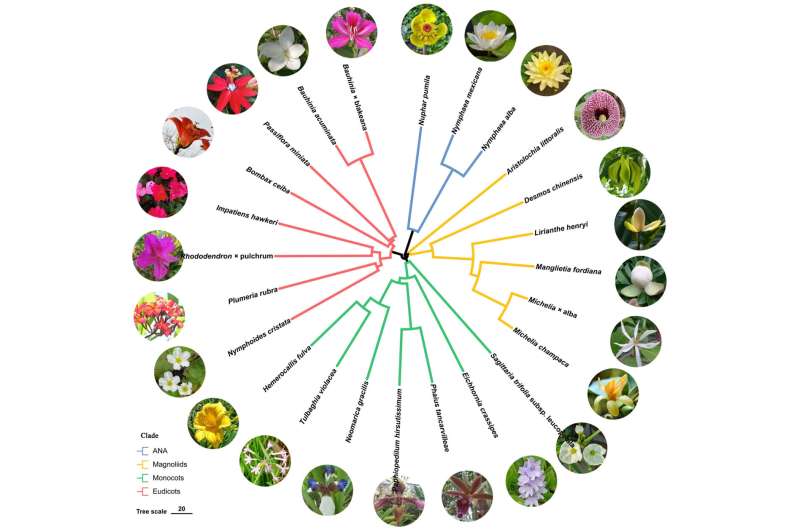This article has been reviewed according to Science X's editorial process and policies. Editors have highlighted the following attributes while ensuring the content's credibility:
fact-checked
trusted source
proofread
How flowers maintain water balance across different angiosperm branches

Flowers play an essential role in maintaining a species' genetic stability. Understanding how flowers regulate water use strategies to adapt to their environment is crucial for better understanding floral evolution and plant-pollinator-environment interactions. However, the mechanisms by which flowers maintain water balance are poorly understood across angiosperm branches.
In a study published in Plant Biology, researchers from the Xishuangbanna Tropical Botanical Garden (XTBG) of the Chinese Academy of Sciences investigated the differences in flower water use strategies between basal angiosperms and derived groups (monocots and dicots).
They measured 29 floral traits related to water transport, storage, and loss in 24 species from the ANA [Amborellales (A), Nymphaeales (N), Austroballeyales (A)] grade, magnoliids, monocots and eudicots.
They found that there is a strong relationship between flower hydraulic structure and function, but this relationship differs between basal angiosperms and monocots/eudicots. Basal angiosperms exhibited floral traits associated with higher water and carbon costs, such as petal stomatal density, stomatal pore area index, pedicel hydraulic diameter, maximum vessel diameter, and theoretical hydraulic conductivity.
Conversely, monocots and eudicots had higher values for traits associated with lower carbon costs, with higher values for traits such as petal epidermal cell size, petal adaxial epidermis thickness, and pedicel vessel wall reinforcement.
Furthermore, there were significant differences in the coordination and trade-offs among floral traits in basal angiosperms, monocots, and eudicots. The correlation between pedicel theoretical hydraulic conductivity and pedicel vessel density was negative only in basal angiosperms, while the correlation between pedicel theoretical hydraulic conductivity and vessel wall reinforcement was negative only in monocots and eudicots.
In addition, there were strong correlations between reproductive and hydraulic traits in flowers, suggesting that changes in water resource availability can significantly affect plant reproduction.
The researchers thus concluded that basal angiosperms maintain water balance with high water availability, while monocots and eudicots maintain a more conservative water balance.
"Our results systematically reveal the variation in economic and hydraulic traits of flowers from different angiosperm branches, deepening our understanding of flower water use strategies among these plant taxa," said Zhang Jiaolin of XTBG.
More information: Y. Ke et al, Monocots and eudicots have more conservative flower water use strategies than basal angiosperms, Plant Biology (2024). DOI: 10.1111/plb.13637
Provided by Chinese Academy of Sciences



















